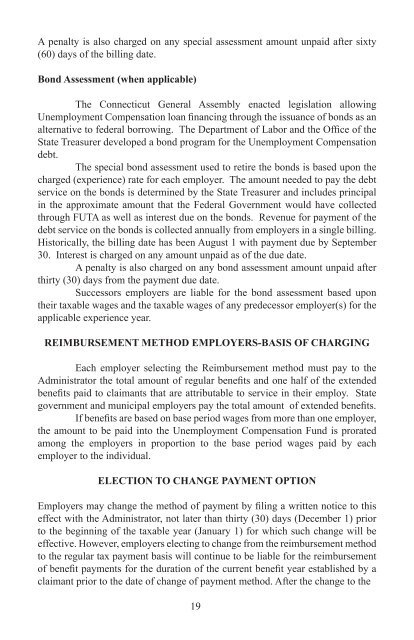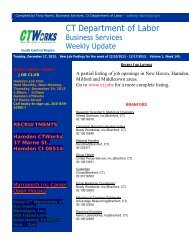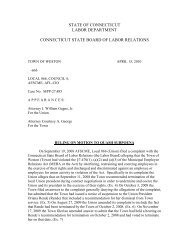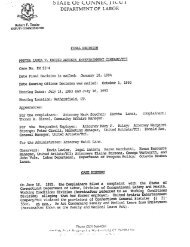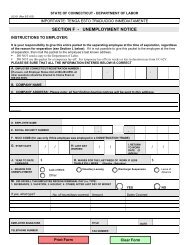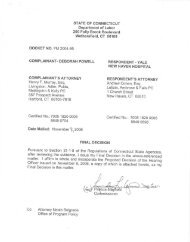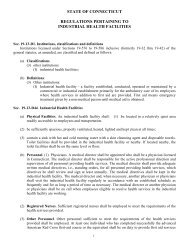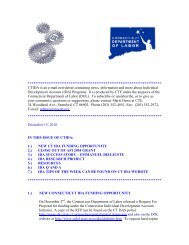Employer's Guide to Unemployment Compensation - Connecticut ...
Employer's Guide to Unemployment Compensation - Connecticut ...
Employer's Guide to Unemployment Compensation - Connecticut ...
Create successful ePaper yourself
Turn your PDF publications into a flip-book with our unique Google optimized e-Paper software.
A penalty is also charged on any special assessment amount unpaid after sixty<br />
(60) days of the billing date.<br />
Bond Assessment (when applicable)<br />
The <strong>Connecticut</strong> General Assembly enacted legislation allowing<br />
<strong>Unemployment</strong> <strong>Compensation</strong> loan financing through the issuance of bonds as an<br />
alternative <strong>to</strong> federal borrowing. The Department of Labor and the Office of the<br />
State Treasurer developed a bond program for the <strong>Unemployment</strong> <strong>Compensation</strong><br />
debt.<br />
The special bond assessment used <strong>to</strong> retire the bonds is based upon the<br />
charged (experience) rate for each employer. The amount needed <strong>to</strong> pay the debt<br />
service on the bonds is determined by the State Treasurer and includes principal<br />
in the approximate amount that the Federal Government would have collected<br />
through FUTA as well as interest due on the bonds. Revenue for payment of the<br />
debt service on the bonds is collected annually from employers in a single billing.<br />
His<strong>to</strong>rically, the billing date has been August 1 with payment due by September<br />
30. Interest is charged on any amount unpaid as of the due date.<br />
A penalty is also charged on any bond assessment amount unpaid after<br />
thirty (30) days from the payment due date.<br />
Successors employers are liable for the bond assessment based upon<br />
their taxable wages and the taxable wages of any predecessor employer(s) for the<br />
applicable experience year.<br />
REIMBURSEMENT METHOD EMPLOYERS-BASIS OF CHARGING<br />
Each employer selecting the Reimbursement method must pay <strong>to</strong> the<br />
Administra<strong>to</strong>r the <strong>to</strong>tal amount of regular benefits and one half of the extended<br />
benefits paid <strong>to</strong> claimants that are attributable <strong>to</strong> service in their employ. State<br />
government and municipal employers pay the <strong>to</strong>tal amount of extended benefits.<br />
If benefits are based on base period wages from more than one employer,<br />
the amount <strong>to</strong> be paid in<strong>to</strong> the <strong>Unemployment</strong> <strong>Compensation</strong> Fund is prorated<br />
among the employers in proportion <strong>to</strong> the base period wages paid by each<br />
employer <strong>to</strong> the individual.<br />
ELECTION TO CHANGE PAYMENT OPTION<br />
Employers may change the method of payment by filing a written notice <strong>to</strong> this<br />
effect with the Administra<strong>to</strong>r, not later than thirty (30) days (December 1) prior<br />
<strong>to</strong> the beginning of the taxable year (January 1) for which such change will be<br />
effective. However, employers electing <strong>to</strong> change from the reimbursement method<br />
<strong>to</strong> the regular tax payment basis will continue <strong>to</strong> be liable for the reimbursement<br />
of benefit payments for the duration of the current benefit year established by a<br />
claimant prior <strong>to</strong> the date of change of payment method. After the change <strong>to</strong> the<br />
19


